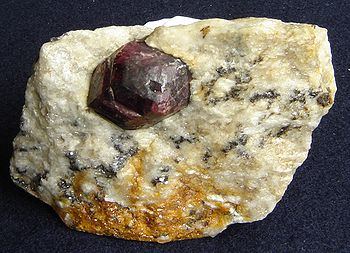Metamorphic Processes
Garnet Gneiss
Metamorphism often occurs on two scales: contact and regional. Contact metamorphism occurs relatively locally, in areas adjacent to igneous intrusions or in areas that are in contact with hot water known as hydrothermal fluids.
Typically this kind of metamorphism is caused by moderate pressure and extreme heat that may last for a period of days to thousands of years. In cases of contact metamorphism, the most extreme metamorphism occurs at the contact point between the parent rock and the intrusive magma or hydrothermal fluid. The degree of metamorphism then decreases rapidly as distance from the heat source increases. Depending on the source, zones of contact metamorphism may range from a few millimeters to tens of meters.
In contrast to contact metamorphism, regional metamorphism occurs over much larger areas. In areas such as rising mountain ranges, large igneous intrusions can form and warp overlying strata increasing the pressures above the intrusion. Also the extreme heat and pressures caused by tectonic forces or deep burial will cause widespread metamorphism.
Recrystallization, Neometamorphism, and Metasomatism
The most common process in the formation of metamorphic rocks is recrystallization. In this process, small crystals of one mineral in contact with one another slowly come together to form fewer larger crystals. For example, the sedimentary rock, limestone. Limestone is composed of microscopic crystals of calcite that once formed the shells of marine creatures. When metamorphosed, those tiny crystals are slowly forced together under high pressure and begin to form larger, more visible crystals of calcite found in the metamorphic rock marble.
In other situations, mineral crystals may completely rearrange to form completely new minerals that are more stable under increased pressure and/or temperatures. This process is known as neometamorphism. This is most often observed with the sedimentary rock shale, which is composed of fine grained quartz, feldspars, and other clay minerals. When metamorphosed, these minerals grains will change to muscovite mica and garnet.
The process of metasomatism results in the loss or addition of chemicals. This can best be seen in the production of anthracite coal, which is almost pure carbon. The parent rock bituminous coal is produced from the aggregation of dead plant material, and anthracite is produced by the loss of the more volatile materials such as nitrogen, oxygen, and methane.

